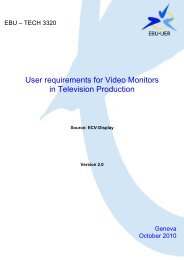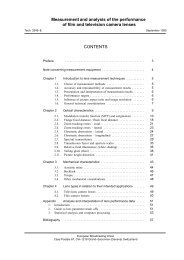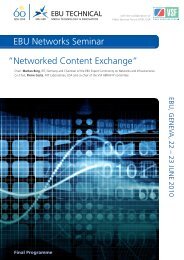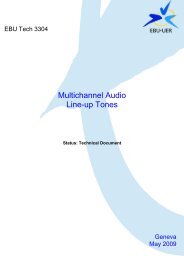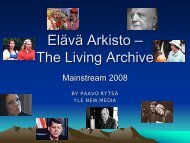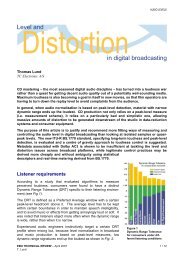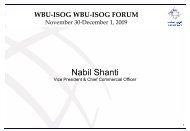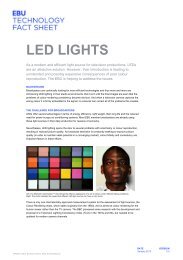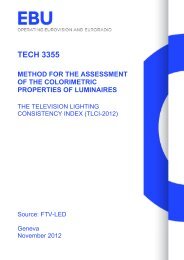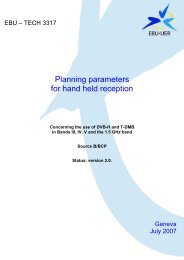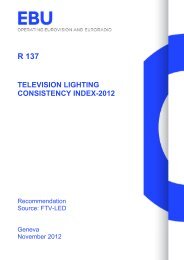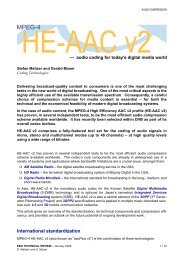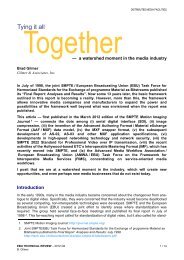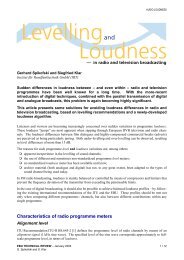Production Technology Seminar 2009 - EBU Technical
Production Technology Seminar 2009 - EBU Technical
Production Technology Seminar 2009 - EBU Technical
You also want an ePaper? Increase the reach of your titles
YUMPU automatically turns print PDFs into web optimized ePapers that Google loves.
Altogether the <strong>EBU</strong> scope is the following one. We started to discuss on asset management. At IBC<br />
2008, some vendors told us “we are already working on SOA, and our Web services are publicly<br />
described”. Other said “This is all the know-how of our company and we do not want to disclose the way<br />
we manage the different functionalities when we pull up one of the Web services”. One of the company<br />
is developing its Web Service Interface as a big bag and you activate only the part of the functionalities<br />
that you need according to the Interface on which you are working. So, the only way is to have a very<br />
high-level abstract Web service description language. The diagram [10] with the Enterprise Service Bus<br />
(ESB) in the middle, the 2 layers of the abstract Web Service Description Language (WSDL) represents<br />
a similar approach as the one from IBM (§ 2.3), and the lower layer is to be managed by different people<br />
to be connected to this SOA layer (cf. Cisco - § Error! Reference source not found.).<br />
Starting from this complete picture, what do we want to do? First, some of the MAM providers are<br />
tempted to take over the layer of the abstract description language. We do not want them to do that. We<br />
think it is not beneficial to the industry and we want it to be open. Second, what can we do to describe<br />
this directory of services? This is where you should know which services are available, if you want to<br />
refine some workflows. And finally, because we have all these problems of interoperability in MXF, we<br />
also have to deal with the lower layers. In order to reach a ‘plug and play’ service description,<br />
discovery and use, we propose to:<br />
� Investigate possible solutions for a common abstract WDSL<br />
o Recommend a preferred protocol for Web Service access ( definition and SOAP<br />
parameters).<br />
o Recommend a common approach to describe the operations / functions available through the<br />
web service ().<br />
o Recommend common rules and formats for message exchange () and common<br />
datatypes ().<br />
o Harmonise service localisation and associated network definitions.<br />
o Support mapping to publicly defined or more abstract WS interfaces from different MAM providers<br />
or manufacturers.<br />
� Register services in a common directory (adapting and restricting the UDDI concepts to production)<br />
o Provide harmonised WS description about functionalities, requested parameters and expected<br />
effects.<br />
o Provide localisation information.<br />
o Support additional profiling (contextualisation) and access information.<br />
An unexpected potential bonus: a metadata logical reference model [12]<br />
We have been working with the identification of metadata at the different interfaces. Considering the<br />
different steps in production, you get technical metadata on the video format, then some editorial<br />
information, some Edit list, and finally publication data. So, all these metadata that you may collect now<br />
through the Web services is going to contribute to your overall data model in your Broadcasting facilities.<br />
What we have done at the start in <strong>EBU</strong> was to develop metadata specifications that look at different<br />
models and tried to make THE metadata model. But we are a little stepping back from this position<br />
(although we have more <strong>EBU</strong> members using P/META that we are still supporting and maintaining). But<br />
on the other hand, because of the impact of Web services on metadata, we now want to have a much<br />
higher Common Logical Data Model (CLDM). It is not a question of structuring this data, but of<br />
understanding what is your amount of data that participates to the logical data model. By doing this we<br />
still benefit from the experience we have gathered embedding the metadata specifications and from the<br />
experience of the <strong>EBU</strong> members. But this logical data model could become a common reference to allow<br />
Broadcasters to discuss between themselves or with 3 rd parties like manufacturers or MAM providers.<br />
For instance, if a broadcaster has a data model, he would map it to this CLDM. A MAM provider mapping<br />
its data model to this CLDM, can then compare its data model to all broadcasters‟ data models, because<br />
he has one common reference to which each broadcaster has mapped its own data model.<br />
Conclusions<br />
File-based tapeless production is becoming a reality, but issues still need to be addressed through<br />
additional rules and guidelines, and <strong>EBU</strong> can help.<br />
Tapeless production is a trigger to develop new architectures and improve asset and workflow<br />
© <strong>EBU</strong> <strong>2009</strong> / <strong>Production</strong> <strong>Technology</strong> seminar / January 27 - 29, <strong>2009</strong><br />
Reproduction prohibited without written permission of <strong>EBU</strong> TECHNICAL & <strong>EBU</strong> TRAINING<br />
25



